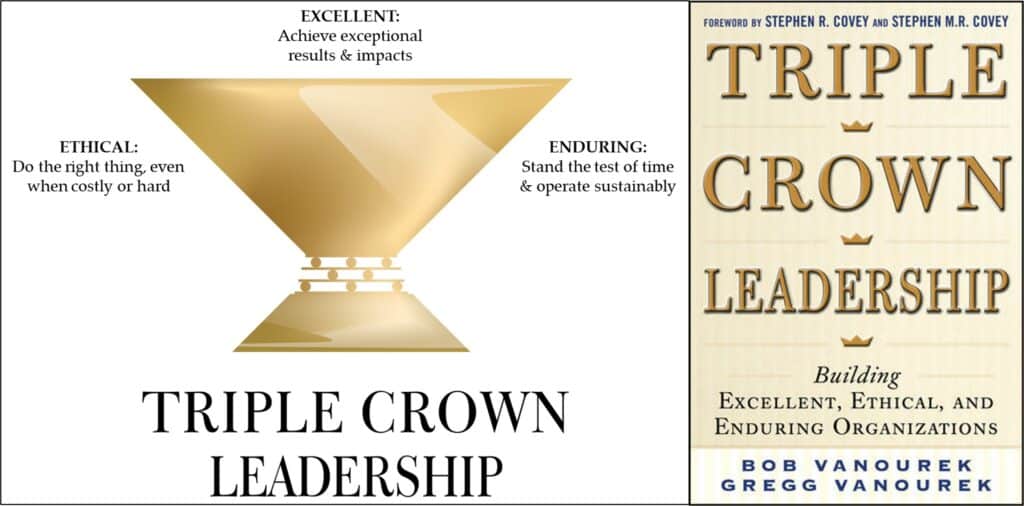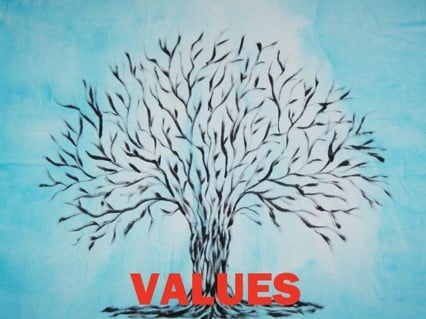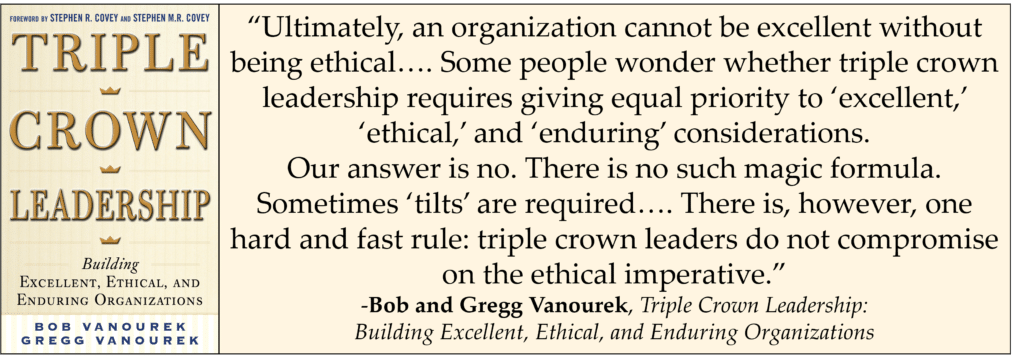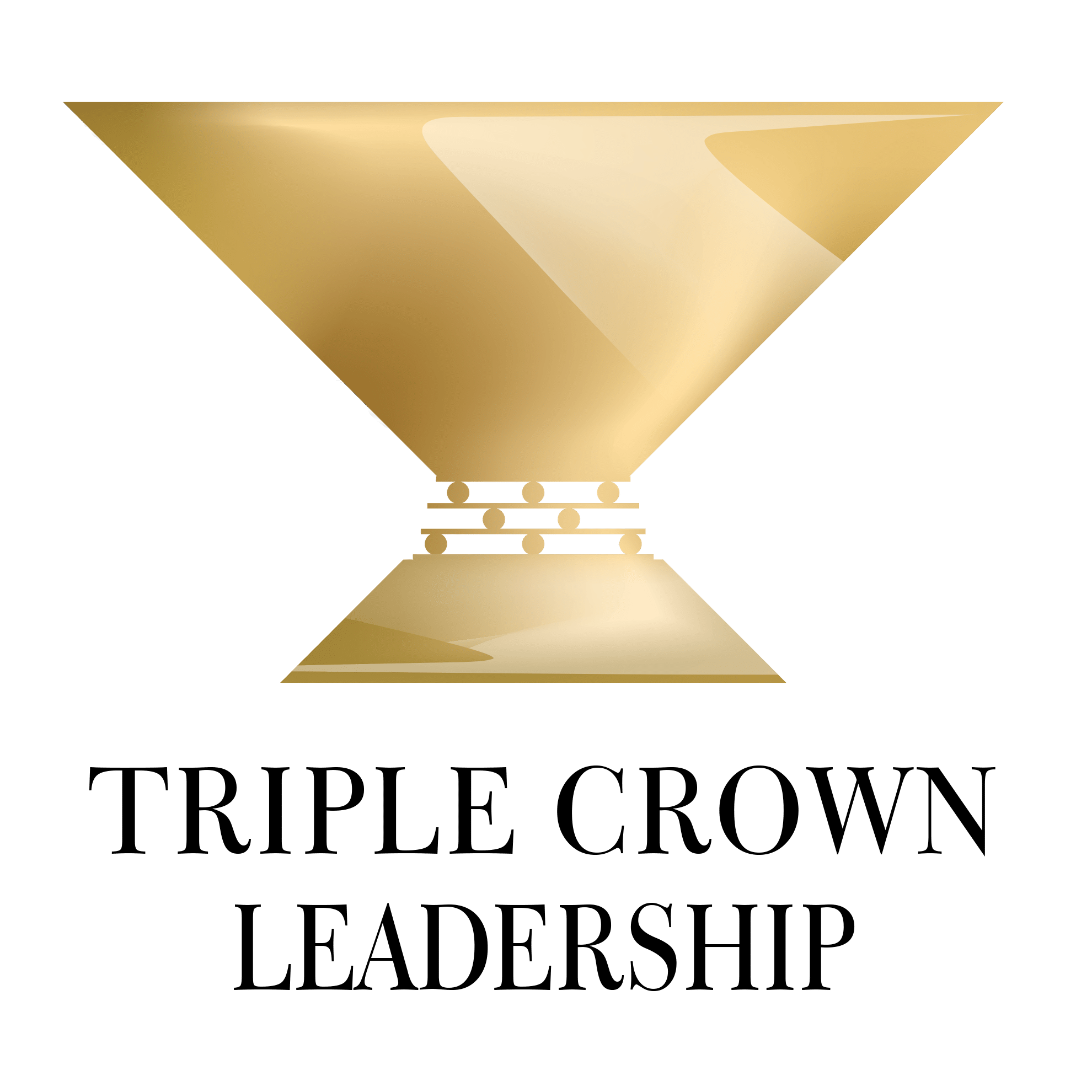When leading people, too often leaders focus on performance while neglecting ethical considerations. Big mistake. Many organizations are deficient in their ethical leadership practices.
To be truly successful, organizations must not only be excellent but also ethical—and not just now but over time. It’s what we call “triple crown leadership”: excellent, ethical, and enduring.

16 Key Ethical Leadership Practices When Leading People
How can you integrate ethical considerations into leading people? Here are 16 key ethical leadership practices:
1. Make a clear and unequivocal commitment to the ethics imperative. That means having an explicit and firm obligation to do the right thing, even when it’s costly or hard.
“… it takes proactive leadership to instill and enforce ethical behavior in an organization.”
-Bob and Gregg Vanourek, Triple Crown Leadership: Building Excellent, Ethical, and Enduring Organizations
2. Clearly communicate why ethical behavior is essential and non-negotiable. Include clear, frequent, and repeated messaging. Set the right tone from the start.
3. Screen for character when hiring. Include deep reference checking with questions about each candidate’s ethics. (1)
“Triple crown leaders watch for signs of integrity flaws in new recruits and colleagues, including excessive ambition, controlling behavior, hyper-competitiveness, bullying, narcissism, arrogance, or greed.”
-Bob and Gregg Vanourek, Triple Crown Leadership: Building Excellent, Ethical, and Enduring Organizations
4. Hire people who fit with your organization’s shared values. That means everywhere: up and down the organization, from board and senior management team members to entry-level workers and all new hires.

Personal Values Exercise
Complete this exercise to identify your personal values. It will help you develop self-awareness, including clarity about what’s most important to you in life and work, and serve as a safe harbor for you to return to when things are tough.
5. Have clear policies about appropriate behavior and how to report, investigate, and address violations. Include provisions for anonymous hotlines, independent reviews, and whistleblower protections.
6. Build ethical dimensions into training and development programs. Begin right away with worker onboarding. In his Harvard Business Review article, “A New Model for Ethical Leadership,” Max Bazerman described how one of his clients created a training video in which four executives related a story about going over their boss’s head when there was an ethical concern or violation. That video emphasized the importance of upholding ethical standards and questioning authority.
7. Conduct anonymous surveys asking about ethical behavior (both victories and violations).
8. Follow up proactively on reports of ethical violations. Be sure to communicate your findings, decisions, and rationale.
“Ethics may start at the top, but managers steer the moral compass of the company. Training people leaders to appropriately act on conveyed misconduct is essential to encouraging a speak-up culture.”
–Erica Salmon Byrne, Chief Strategy Officer, Ethisphere
9. Factor ethical behavior into performance reviews. (2) This will help incentivize good behavior.

Leadership Derailers Assessment
Take this assessment to identify what’s inhibiting your leadership effectiveness. It will help you develop self-awareness and identify ways to improve your leadership.
10. Recognize people for moral courage and upholding the organization’s shared values. Celebrate that. Spread the word far and wide to send a clear and unmistakable signal.
11. Distinguish between “stars,” “high-potentials,” “vampires,” and “zombies.”
- Stars maintain high performance and ethical behavior.
- High-potentials are high in ethical behavior but their performance isn’t yet up to snuff.
- Vampires are high in performance but behave unethically. (They’re often the most problematic, since many leaders ignore their ethical abuses, letting them poison the culture.)
- Zombies are low in both performance and ethics.

12. Make sure compensation and other systems aren’t incentivizing unethical or questionable behavior. Instill disciplinary measures for bad actions, including ways to reduce or recoup compensation (including bonus clawbacks) for ethical violations. For everybody in the organization.
“Organizations must also create systems and processes for instilling ethics into the enterprise, covering all aspects of the operation, from recruiting and rewarding people to reporting abuses and maintaining transparency.”
-Bob and Gregg Vanourek, Triple Crown Leadership: Building Excellent, Ethical, and Enduring Organizations
Common Examples of Dangerous Incentives:
- Sales Quotas: Workers with aggressive sales quotas may resort to unethical practices (e.g., exaggerating product benefits, misleading customers) to meet their targets.
- Bonuses: Rewarding workers based solely on financial metrics can incentivize cutting corners (e.g., manipulating data, ignoring safety protocols).
- Stock Options: Workers (especially executives) may manipulate earnings to inflate stock prices and boost the value of their options.
- Commission-Only Pay: Salespeople who rely solely on commissions may misrepresent product features or pressure customers into unnecessary or redundant purchases.
- Rewards for Speed: Production quotas may lead workers to take shortcuts, bypass safety procedures, or deliver sub-par work to hit their targets.
13. Ensure all workers have opportunities for career growth and advancement. Avoid office politics and favoritism.

Alignment Scorecard
When organizations aren’t aligned, it can reduce performance dramatically and cause frustration and dysfunction. With this Alignment Scorecard, you can assess your organization’s level of alignment and make plans for improving it.
14. Be forthright and transparent about ethical challenges and problems. Communicate openly, widely, and frequently.
15. Create a psychologically safe and inclusive work environment. Make sure everyone feels valued.
16. Address discrimination and harassment swiftly and firmly.
Conclusion
Great leaders prioritize ethical leadership practices in all domains, including people practices. They focus on building organizations that are not only excellent but also ethical and enduring—the “triple crown of leadership.”
–Gregg Vanourek

Reflection Questions
- How are you and your organization doing when it comes to ethical leadership practices surrounding people?
- What more will you do, starting today?
Tools for You
- Leadership Derailers Assessment to help you identify what’s inhibiting your leadership effectiveness
- Personal Values Exercise to help you determine and clarify what’s most important to you
- Alignment Scorecard to help you assess your organization’s level of alignment

Leadership Derailers Assessment
Take this assessment to identify what’s inhibiting your leadership effectiveness. It will help you develop self-awareness and identify ways to improve your leadership.
Related Articles & Resources
- “How Ethical Leaders Approach Decision-Making”
- “Ethical Decision-Making: Simple Tests”
- “Ethical Leaders: What They Do that Others Don’t”
- “3 Things Ethical Leaders Ask and Say”
- “17 Steps to a Thriving Ethical Culture”
- “Leadership and the Ethics Imperative”
- “Why Are We Talking about Ethics?”
- “The Ethical Challenges Faced by Leaders”
- “Are You Strong Enough to Be a ‘Voice of One’?”
- “The Importance of Trust in Leadership”
- “The Importance of Credibility in Leadership”
- EY, “How Can Trust Survive without Integrity?” EY Global Integrity Report 2024, EY Forensic & Integrity Services
- Bob and Gregg Vanourek, Triple Crown Leadership: Building Excellent, Ethical, and Enduring Organizations
Postscript: Quotations on Ethics and Leading People
- “Do not compromise on the ethical imperative…. Leaders have to draw the line.” -Bob and Gregg Vanourek, Triple Crown Leadership: Building Excellent, Ethical, and Enduring Organizations
- “The obligation of the ethics and compliance function is to investigate with equal zealous and enthusiasm the complaints of employees irrespective of their rank in the organization. Once the investigation is completed, it is imperative the business follows through on the necessary findings.” -Marcel Cordero, Legal & Compliance Director, Alicorp
- “We are all flawed. Since we all make mistakes, we are wise to solicit help and input from others as sounding boards and accountability agents. Heated debates occur among reasonable people who can disagree on what is ethical. Such debates can be healthy and help maintain the ethical imperative.” -Bob and Gregg Vanourek, Triple Crown Leadership: Building Excellent, Ethical, and Enduring Organizations
- “Corporate integrity is about choosing ethical courage over convenient shortcuts, prioritizing what is right over what is profitable, and embodying the company’s core values in every action, not just in rhetoric.” -Arpinder Singh, Global Markets and India Leader, EY Forensic & Integrity Services
- “Better to fail with honor than succeed with disgrace.” -Bob and Gregg Vanourek, Triple Crown Leadership: Building Excellent, Ethical, and Enduring Organizations

(1) Also consider running background checks on prospective candidates before hiring them and conducting due diligence on customers and key suppliers, vendors, and partners.
(2) For performance reviews, Zappos focuses on worker performance for half the review and how workers honor the shared values and support the organization’s culture for the other half. Amgen has a system in which performance appraisals focus on 50% on performance and 50% on values. The senior management team at Appletree Answers made values a third of the weighting on worker performance reviews, for everyone in the whole company at all levels. All feedback was centered around the values. (Source: Raj Sisodia and Michael Gelb, The Healing Organization.)

Triple Crown Leadership Newsletter
Join our community. Sign up now and get our monthly inspirations (new articles, announcements, opportunities, resources, and more). Welcome!
+++++++++++++++++++++++
Gregg Vanourek is a writer, teacher, and TEDx speaker on leadership and personal development. He is co-author of three books, including Triple Crown Leadership: Building Excellent, Ethical, and Enduring Organizations (a winner of the International Book Awards written with his father, Bob Vanourek) and LIFE Entrepreneurs (a manifesto for living with purpose and passion, written with Christopher Gergen). Check out his Leadership Derailers Assessment or join his rapidly growing community. If you found value in this, please forward it to a friend. Every little bit helps!


